DPR recently declared the a7RIV the best landscape camera. They didn’t consider the GFX 100. I’ve done some tests of the two cameras, with the Fuji coming out on top in image quality. Today, I did a comparison of the two cameras aimed particularly at landscape use. I used very sharp lenses: the Fujifilm 110 mm f/2 on the GFX 100 and the Zeiss Otus 85 mm f/1.4 on the a7RIV.
Here’s the scene, with both camera/lens combinations:
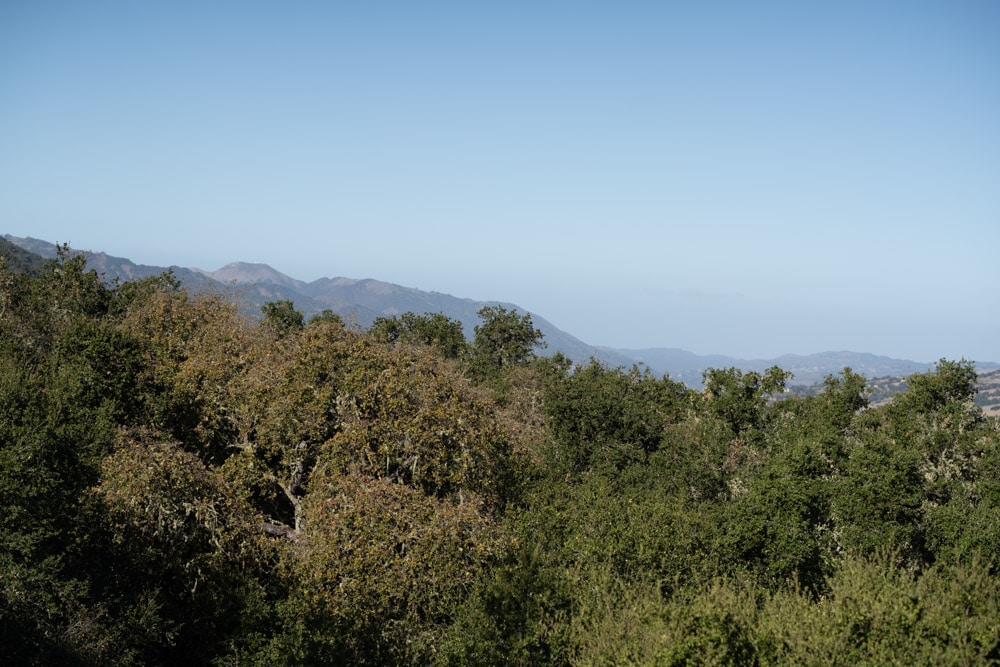
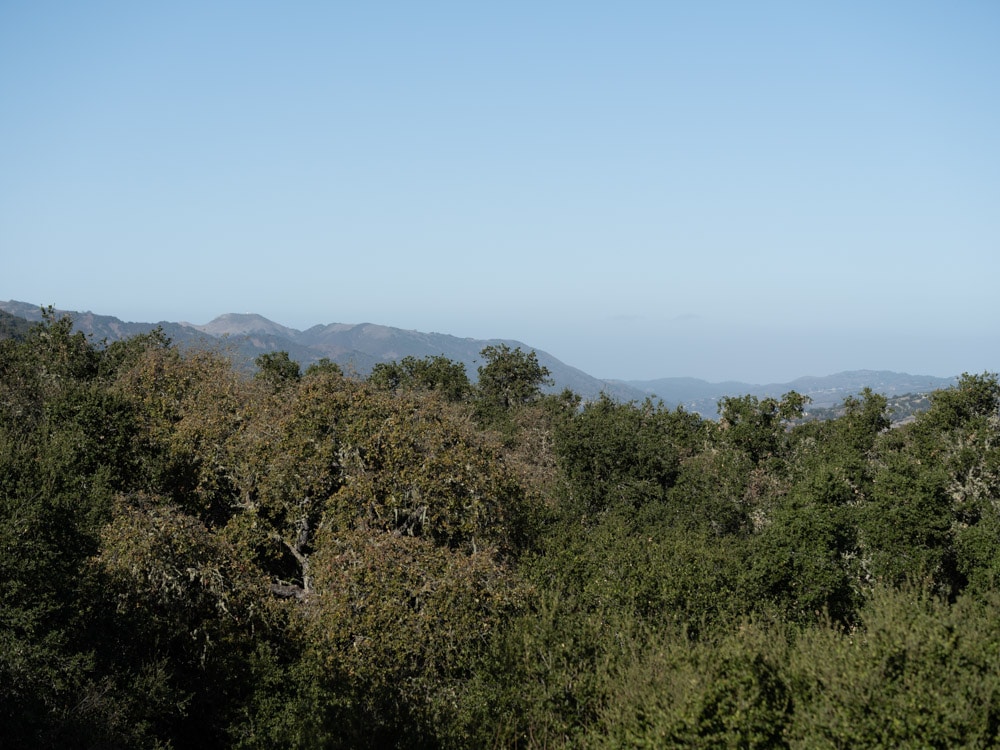
I made exposures with the following equipment and settings:
- RRS 4-series Versa legs
- Arca-Swiss C1
- 2-second self timer
- Electronic shutter
- ISO 100
- AF-S for the GXF 100, manual focus for the a7RIV at taking aperture
- f/2.8, f/4, f/5.6, f/8 for the a7RIV, f/4, f/5.6, f/8, f/11 for the GFX 100
- 1/3200, 1/1600, 1/800, 1/400 second shutter speed for the a7RIV
- 1/1600, 1/800, 1/400, 1/200 second shutter speed for the GFX 100
I developed the images in Lightroom with
- White balance set to Daylight
- Adobe Color Profile
- Sharpening: amount 20, radius 1, detail 20
I picked the sharpest of the three exposures. If you’ve seen these here before, just jump to the images. If not, I need to spend some time telling you how to interpret them. They’re at roughly 200% magnification, enlarged to 700 pixels high on export from Lightroom. If you just want a rough idea of the differences, just look at the images as displayed in-line in the posts. However, if you wish to compare these images in detail, you should view these images by clicking on them to see the source files, then set your browser for 100% zooming. Even better, download them and make Photoshop stacks.
No matter what you do, these crops are all going to look horrible. I’m blowing them up so much so that they will represent the original file after JPEG’s discrete cosine transform has had its way with them. If you want to get a good idea of what the images would look like printed, get far away from your monitor. No, farther than that. Put a bunch of the images up on the screen and back up until the best one starts to look good. Then look at the others. There’s another reason why these images won’t look like the best thing the camera/lens combination can deliver. They’re demosaiced with Lightroom. Lightroom is not awful, but for a particular image, there are usually better raw processors. I use Lr because it’s a de facto standard, because I know it well, and because it’s got good tools for dealing with groups of images.
Here’s how to use these highly-magnified crops. The crops are normalized by image height. The dimensions of the a7RIV sensor is 9504×6336 pixels. If we make a full-frame print from the a7RIV on a printer with 360 pixels per inch native driver-level resolution, like the Epson inkjet printers, we’ll end up with a 26.4×17.6 inch print. The 365×283 pixel crop you’re looking at will end up 1×0.7 inches. Let’s imagine that you or your viewers are critical, and will look at the 26.4×17.6 inch print from about 20 inches (conventional wisdom is that the distance would be a little greater than that, or 32 inches (the diagonal). The dimensions of the GFX 100 sensor is 11648×8736 pixels. If we make a full-frame print from the GFX 100 on a printer with 360 pixels per inch native driver-level resolution, like the Epson inkjet printers, we’ll end up with a 32.4×24.3 inch print. The 448×347 pixel crop you’re looking at will end up roughly 1.4×0.9 inches, but the field of view for a same-sized print is the same as for the a7RIV crops, and if we print both prints the same size, proportionally the same resampling will take place.
The next step is dependent on your monitor pitch, which you may or may not know. Turns out, you don’t have to know it. Just take the crops and view then at 1:1. How high are they? Get out your ruler and measure, or just guess. Let’s say they are 6 inches high. 6 inches is about 5.5 times 0.7, so in order to view the crops the way they’d look from 20 inches on the print is to view them from 5.5 times as far away, or about 8 feet.
In the center, at about 100 meters distance:
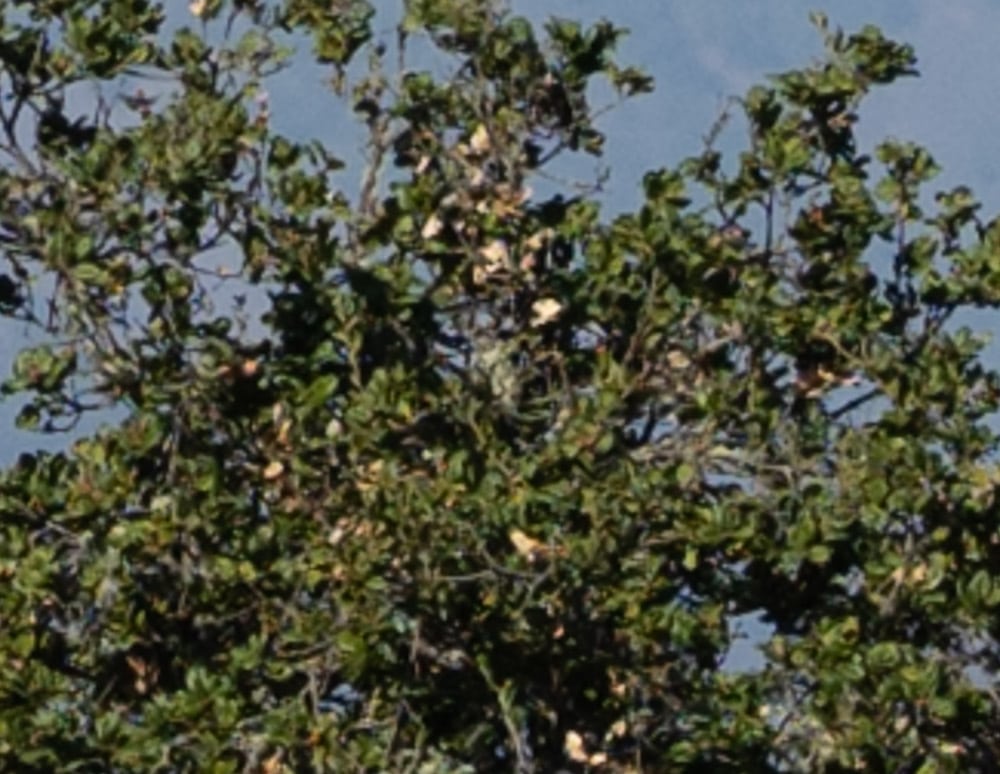
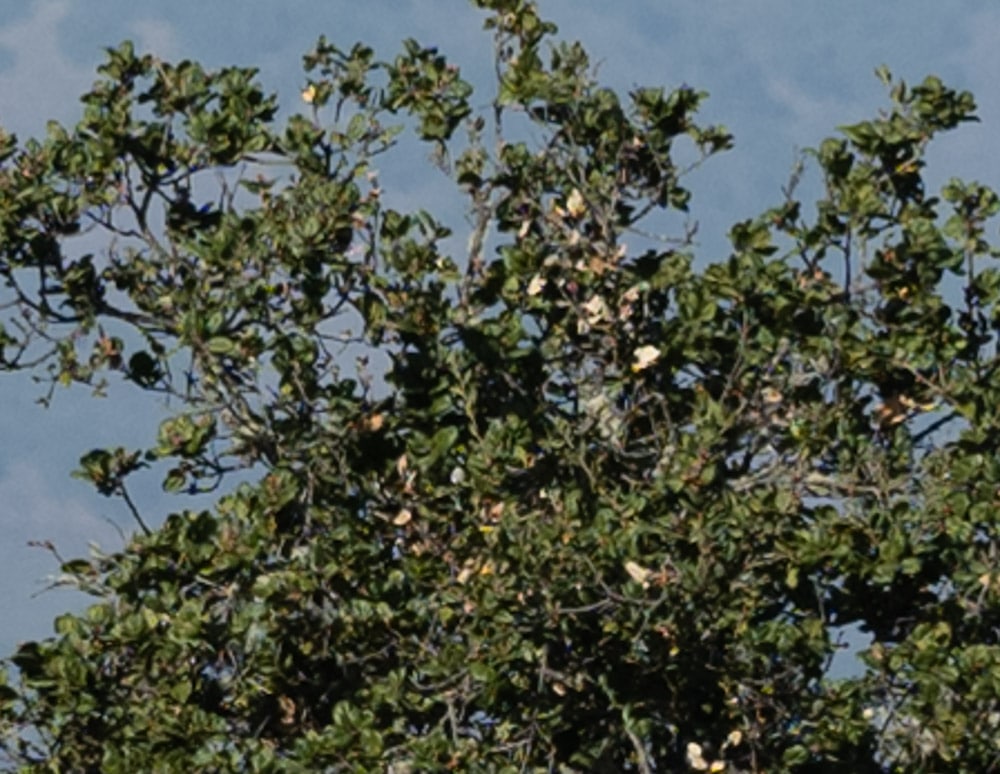
The GXF 100 image is much crisper.
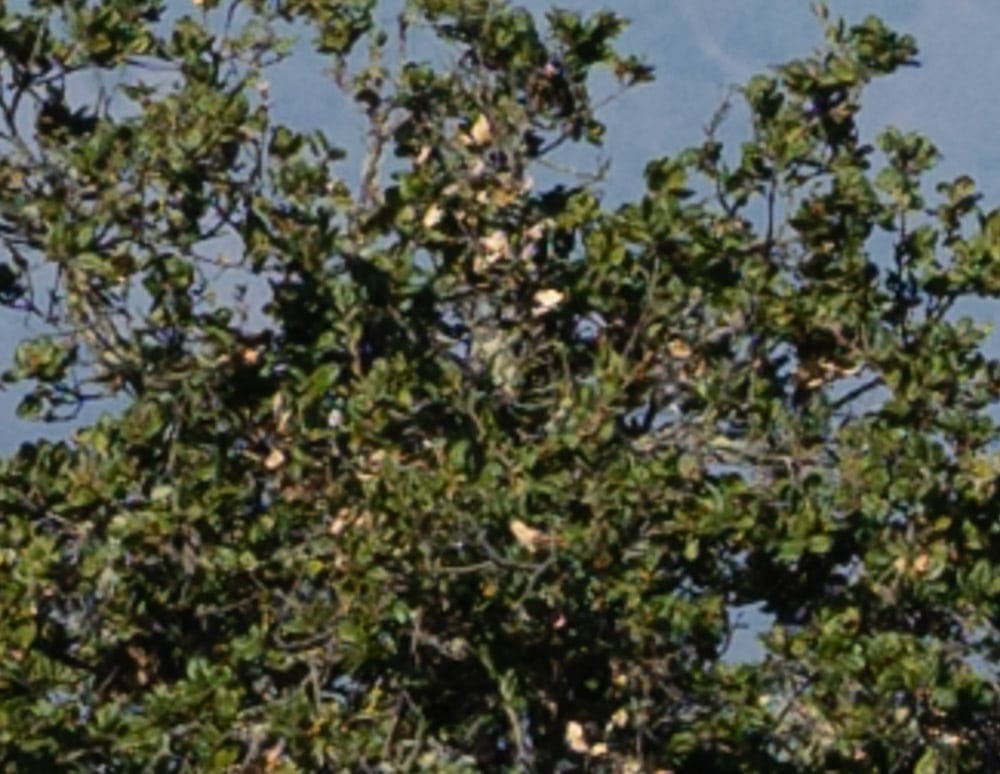
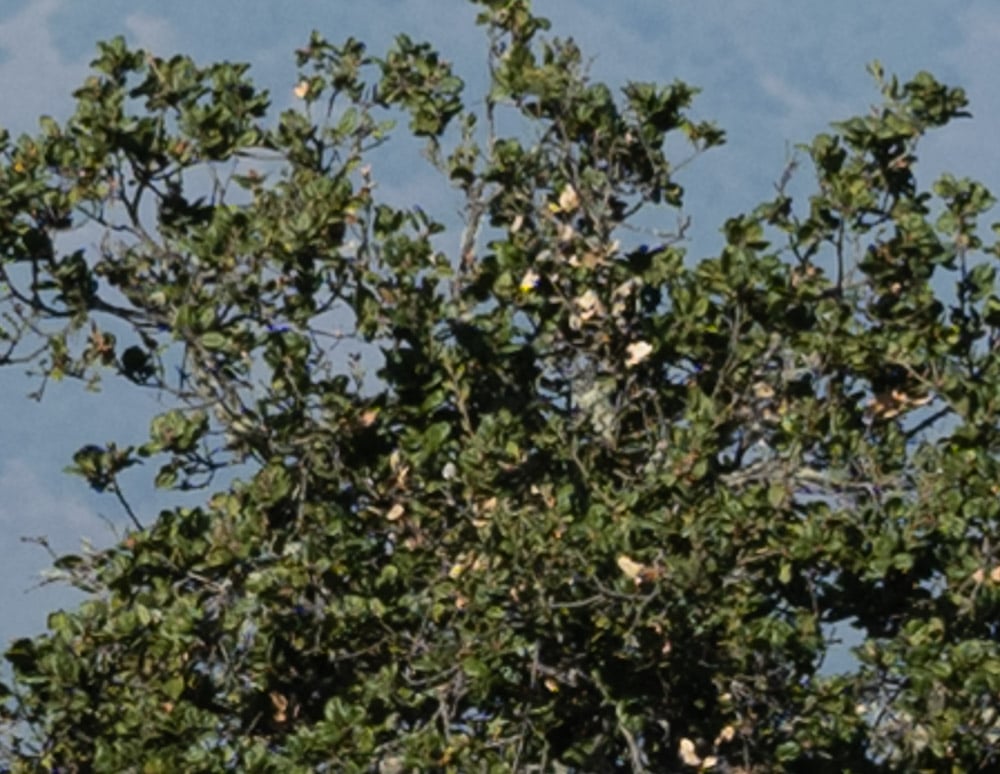
The GFX 100 is a better image.
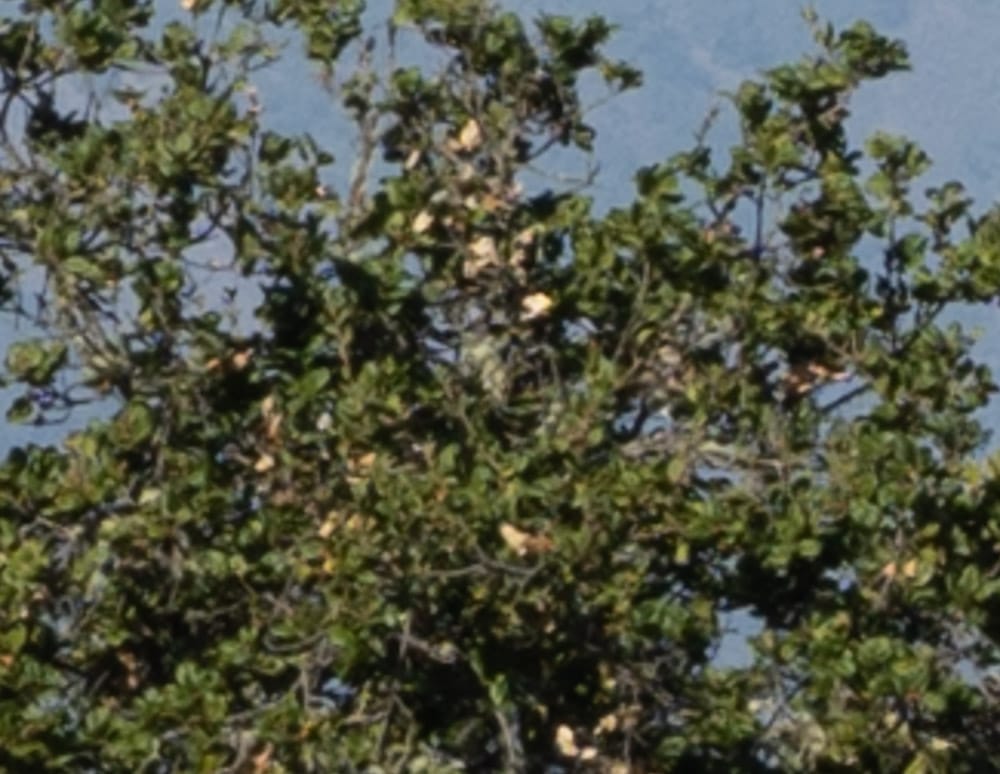
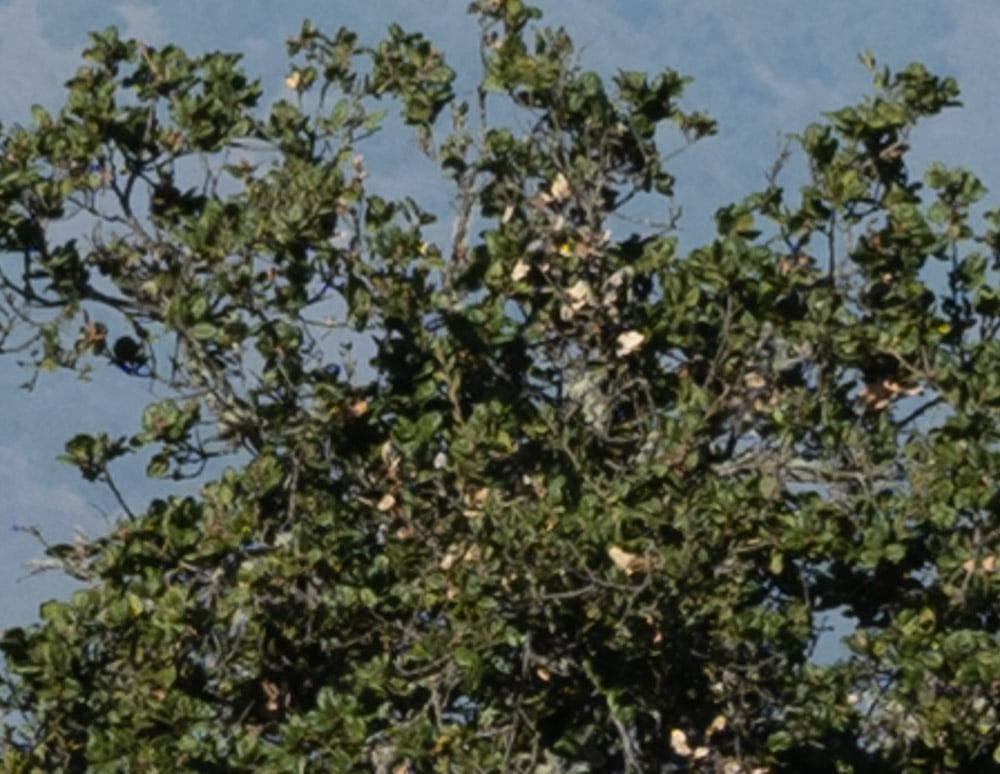
Even with easily-perceptible diffraction, the GFX 100 image is still distinctly better.
Surely one more stop will even things out, right?
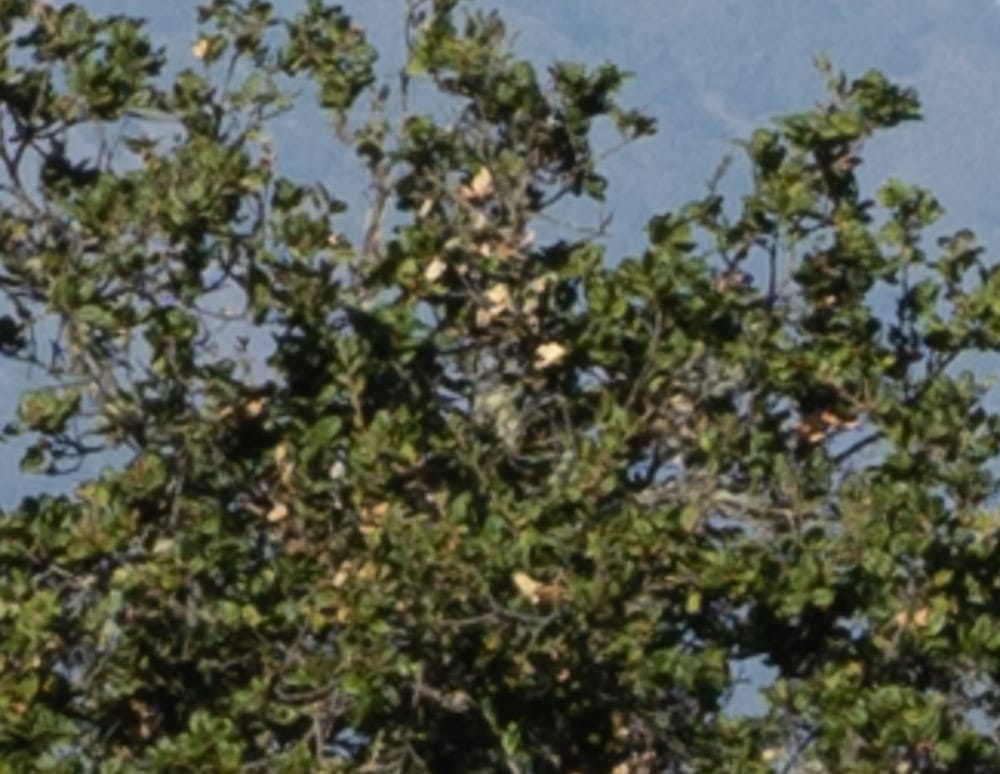
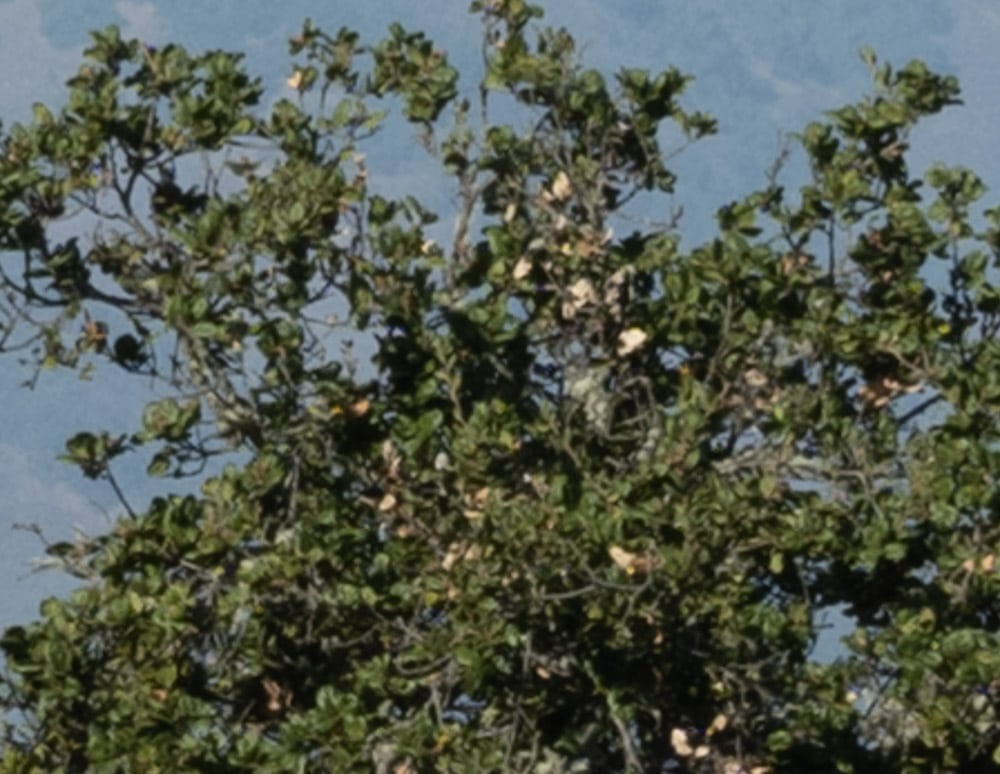
It’s closer, but the GFX 100 is still distinctly better.
I’m sure there’s an equivalent f-stop pair narrower than the above that reduces the differences between the two cameras to a virtual tie, but I’ve just shown you the most common landscape apertures.
Why didn’t I use the Sony pixel-shift feature for this scene. I have found that for landscape use in general, that motion artifacts make it unusable. There are some landscape subjects — like roots and rocks — that work fine with pixel shift, but foliage does not, even when you think the wind is still.
Jack Hogan says
Point well taken, Jim.
One thing I noticed when switching from 24 FF MPs to more than 40 for Landscapes is, to my surprise, noise when shooting without a tripod: auto ISO keeps shooting up higher than I am used to with all that that entails. Thoughts?
JimK says
You can take comfort in the fact that, in same-size prints, camera motion has the same effect regardless of sensor resolution. But, presumably, you increased the resolution of your camera so that you could get more resolution in the print, so you’ll have to increase the shutter speed by a factor of sqrt(42/24) or sqrt(45/24) to keep the blur the same on a per-pixel basis.
And, as Fred pointed out in a comment to this post, equivalent stops assume that you are not limited by exposure time.
jeff says
Auto iso might be your problem. Don’t use it you’ll be happy to move away from letting the camera think instead of controlling all aspects of the photo.
JimK says
What makes you think I use auto-ISO? It says in the post that I used ISO 100. Maybe you meant to reply to Jack?
FredD says
Jim, I understand the basis for you using “equivalence” in f-stops for your comparisons across different formats, but I would also note that there can be plenty of scenes where both total amount of light striking the sensor and depth-of-field are not critical/limiting, and equal shutter speeds may be the important consideration. (For example, if I want not frozen but rather a particular amount of subject motion in a moving person, or flowing water, or a flag blowing in the wind — but also would like other, motionless parts of the scene sharp). Assuming same ISO, that same shutter speed constraint implies the same f-stop. So, I would say that one could argue for consideration of comparison pairs at equal, not equivalent, f-stops. (If making an exposure series, the images are already captured, I’m just talking about an additional way to look at them. Granted, in this case, it’s only one stop difference. But across larger format differences, it’d be more).
In other matters related to the Fuji, I’ve got to stop reading your blog! — because every time you do another one of these tests on the Fuji, I want one! Even though by rational analysis of my camera uses, and sore back, I can’t justify buying anything of that cost-size-weight (and won’t).
JimK says
At the f-stops used, comparing images at the same f-stop will favor the Fuji camera even more than the one-stop differences used in the pairings above.
CarVac says
Even with equivalence you could raise the ISO and still come out ahead sharpness-wise with the larger sensor.
Ilya Zakharevich says
Fred, EQUIVALENCE is total. In particular, it means “equal shutter speed”.
(Well, what it does not mean is equality of “ISO numbers”. You equalize photons captured, and since with larger sensor you use smaller ƒ-fractions [larger ƒ-denominators], this means that you should dial a different ISO number into your light-meter.
Similarly, you may need to dial a different full-well into your camera. [Usually, this is also named “ISO number”, although, unfortunately, it is an orthogonal feature.]
Anyway, “ISO number” is such an artificial concept that it makes very little sense to discuss it “scientifically”. Just look in the ISO standard: a complete mess!)
Phil says
While hiking, the photographers I’ve met with heavy cameras leave them in their backpack or at home. They do not take off their backpack and use the camera because it’s too much effort. By lunchtime they won’t use it much either because they want a rest.
The Sony is on the line of being too heavy for some people but it’s not too bad with the 16-35mm f/2.8 gm lens (a very common landscape focal length). The fujifilm is certainly too heavy to hike long distances with comfortably if you’re carrying lots of food. I’ve never seen anyone out hiking with an otus. I’m sure they exist somewhere, but it’s rare. So the real world weight is much lower, especially if they use a zeiss e-mount prime. The Sony also allows you to power it from a solar panel, and it is small enough to put it in a common ziplock bag with silica gel while sleeping, if you’re out camping.
For those that are purely interested in getting a shot and can drive to a location or hire a helicopter, the GFX will yield better results for sure. I’d argue this demographic can go one step further and use a camera with an even bigger sensor than the GFX. I’m not sure why they picked those dimensions, but it’s certainly not the “large format” it’s advertised as.
Ultimately it depends on the landscape of course so the best we can do is make generalisations, and in general I think the Sony is miles better. I am not denying its sensor performance but it seems pointless if it stays in your bag. For studio portraits, I’d argue differently but for the average landscape photographer on dpreview, I think their conclusion seems to be fair.
K Cox says
This argument rests primarily on a premise that is somewhere between gross exaggeration and total falsehood: that people hiking to a location and packing in, say, a GFX100 with, say, a GF23 and/or GF32-64 would “leave it in the bag.” The idea that any serious landscape photographer would hike for miles with a camera that he would then choose to leave in his backpack is, well, unbelievable. Would a (very) casual amateur who isn’t really a serious photographer do such a thing? I suppose…though it’s kinda dumb.
Further, the premise that either the A7R4 or the GFX100 are aimed at “the average landscape photographer on dpreview” is equally silly, so that doesn’t really save the analysis. These are flagship cameras, very expensive cameras, and especially in the case of the GFX100, hardly meant for “average” photographers of any type, especially those who would pack up a bunch of photography gear and then carry it around for miles, never taking it out of their bag.
I’m sure there are some good arguments for the Sony. You didn’t make them.
Den says
‘Lightroom is not awful, but for a particular image, there are usually better raw processors’
I’d be very interested to see this validated with A7RIV files.
Scott Pilla says
Jim, interesting and rigorous post as usual. I’d be interested in seeing a similar comparison with the gfx50r or 50s to the A7RIV.
Per Sabelström says
Jim, thx a lot for this!
My conclusion from this is that the otus is defect!
Here’s my reasoning:
F-number is a physical constant. (Not talking about apparent F-number that is useful for calculating DoF) If you put an otus (with adapter) on the GFX100 it still is 1.4)
Both cameras have near identical pixel pitch (3.73 – 3.75 microM)
Diffraction can be described as the size of the airy disk.Airy disk is ONLY dependent on F-number.
Therefore if the lens is “good” it will be sharpest just before diffraction sets in.
So both setups should peak at the same F-number.
I know some will argue that since the crops from the two setups dont have the same pixelcount that that will somehow invalidate my argument.It doesnt; scale doesnt enter into this – if a lens is sharpest at F:X (X=4.0 or 5.6 or…) i is sharpest at that setting independent of scale.
my 2c
JimK says
I didn’t test the lenses at their sharpest stops, although f/4 isn’t far off from the best the Otus can do. I tested than at apertures likely to be used for landscapes. I’ve had the Otus for years. It is not defective.
On an unrelated point in your comment, diffraction is present at every f-stop.
Wayne Shumaker says
I assume the Zeiss Otus 85mm was a Nikon mount adapted to the Sony? If so, there could be a difference in lens sharpness performance due to sensor stack differences. A super sharp lens on a native camera may not be as sharp when adapted to another camera. The Nikon and Sony sensor stack may be close enough to be OK. Check this article.
https://wordpress.lensrentals.com/blog/2014/06/sensor-stack-thickness-when-does-it-matter/
JimK says
I have tested that lens on the D850, Z7, a7RII, a7RIII, and a7RIV. There is no significant difference in its performance on those bodies, except for the sensor resolution differences.
Frankie Sweets says
Thanks for this. I’ve been going nuts comparing the A7r4 and the GFX100. I’m a long time sony shooter but still on APS-C. I’ve shot film (and still do) since the 80s. For about a decade in the 2000s I also shot MF film but it just became too much of a pain to deal with developing and getting good scanning.
It’s not so much the detail that keeps drawing me back to the GFX – there’s a certain depth that I see in the photos that I never see in the Sony photos. I’ve downloaded tons of RAWs of both and developed them on my own the way I would and no matter what there’s always a depth to the photos from the GFX that really remind me of the way I’m used to seeing on film prints.
I have no idea if it’s the tonal graduation, dynamic range, exposure latitude, or any number of factors but I can always pick out a GFX photo because of the depth in the photo. Even in this comparison, the A7R4 shot looks flat to me.
I’m a long time Minolta shooter and have a number of the high end Minolta lenses so I’d love the sony to stay on top so I can keep my lenses but I just can’t get past the lack of depth in the Sony photos every time I see them.
Do you have an opinion on this? Have you noticed this phenomenon in your photos from the GFX?
Thanks a ton –
Frank
JimK says
No.
No, in the sense that I have seen nothing mysterious or ineffable.
Frankie Sweets says
Much appreciated. I’m not sure if it’s just contrast differences or the RAW program’s renderings (I use Silkypix). I thought the larger sensor might capture tonal graduations better but the pixel pitch between a 100mp MF sensor and a 60 mp FF sensor (in the A7rIV) is almost the same so I got the impression the sensor would be near the same (meaning the A7rIV sensor is almost just a 60mp ‘crop’ of the GFX 100mp sensor).
It could just be contrast differences or color. It’s very hard to compare apples to apples as you rarely see the same photo taken by both cameras so your posts on the two together are really the first time I’ve had a chance to see that.
Your response was much appreciated. Thanks.
Frank
JimK says
It is exactly the same if you’re talking about the 61 MP sensor in the a7RIV and the 100 MP sensor in the GXF 100..
It pretty much is. GFAs are different, of course. Microlenses may be slightly different. Conversion gain management is slightly different.
Seth says
I’ve noticed the same. Thought it was just me.
QuietRoads says
What does one do with 100mp? Even 60+ seems potentially excessive. If it were all about pixels, wouldn’t D5 users throw their cameras away? And if it is all about pixels, why stop at 100 when 400 is possible?
JimK says
As far as I’m concerned, the biggest advantage of really high pixel counts is reduced sampling artifacts. I can see the difference between a GFX 100 and a GFX 50 or Z7 in C-sized prints of many types of subjects, and it really stands out in 24×30 or 30×40 inch prints.
If you know that 400 MP is commercially feasible in 2020, you know something that I don’t know. I would love to see that. I’ve calculated before that when we get to about 800 MP with most good lenses, we should see no sampling artifacts.
JimK says
There are many photographic pursuits for which 20 MP is sufficient. In fact, there are many tasks for which 6 MP is plenty.
Edwin Schottstaedt says
I currently stitch 10 to 20 GFX 50s files together creating files over a gigabyte to create 4×8 foot prints on metal… so for me the more the better to a point as most printers cannot print the detail that is in the stitched image…
ChrisX says
Maybe I am standing on the line, but to me, there is something wrong: A7R4 has 61 Mpx, GFX100 has 100 Mpx. So making a crop of the same CONTENT, the A7R4 crop should be smaller due to less pixels per area. If you choose the same amount of PIXELS, then the crop of the A7R4 would contain more scene (be wider).
But with your crops the opposite is the case! There seems to be something messed up.
Also why didn’t you use AF for the Sony? If you are using an adapted lens unable to AF, then the final resolution is limited to your ability to focus properly. A bit unfair in my eyes.
JimK says
The crops are the same fraction of the respective picture heights. So the GFX 100 has more pixels before they are upsampled to the same resolution for web viewing.
I didn’t use AF for the Sony because the Otus doesn’t support it. Manual focusing is slightly more accurate with the 110/2 than AF, but, since I took three shots at each setting and picked the best, the result with the GFX 100 would have been the same had I used MF.
And the final resolution is not limited by focus. The three images in each set were substantially identical.
ChrisX says
Jim, you surely had your reasons for doing this, but I don’t think this a good approach to upsample crops.
Especially when you apparently did not upscale both crops equally and fairly by a factor of 2.
Anyway, it would have been much better to stick with 100% crops and then compare what the cameras achieve at maximum native pixel peeping size with their respective sensor.
As it is, the heavier upscaling for the Sony may dominate the subjective impression of less detail.
JimK says
What I did mirrors what would happen if you made same-sized prints from both cameras. If I could have let you see same-sized prints over the web, that’s what I would have done. There is nothing unfair about comparing cameras with same-sized output.
ChrisX says
Totally agree with that. But I can’t match that to the crops. The full shot shows the A7R4 to be a bit wider. If the shots would have been printed same size, then the same piece of paper area e.g. 5 x 5 cm would show a bit wider content.
Yet your crops show the opposite, the GFX100 crop showing a wider section of the tree. This is what continues to derail me 🙂
JimK says
The lenses aren’t precisely equivalent. That was as close as I could get. The images were normalized by image height, not image width. By that metric, the equivalent of the 110 on the GFX 100 is an 80 mm lens on the a7RIV. 85 is a bit longer than that. Using image width for normalization would result in 90 mm on the a7RIV being equivalent to 110 on the GFX.
JimK says
The field of view would have been quite different in that case.
ShootPD says
Thanks for the comparison. Curious why the A7RIV subject seems larger than GFX 100 subject. Wouldn’t the subject in the GFX 100 image appear larger due to more pixels?
JimK says
Reread the section on how to use the crops. They are scaled to the same print height, and the lenses are not precisely equivalent.
Peter Holzhauer says
Great tests Jim. Did you buy the GFZx 100s?
Do you think using F16 on the A7r4 with a Batis 40 on a tripod and one exposure would be noticeably inferior to the same shot with the GFX 100S with GF 50mm at F22?
I know that diffraction is kicking in at these F-stops but I’ve made some 40 x 60 prints from my A7r3 with the above Aperture and lens combo on a tripod, and simply sharpened the files a bit more aggressively then I usually do and it looked pretty good on the wall. I also realize that focus stacking and using a smaller F-stop would theoretically give me a better file, but in practical experience in the field, I’ve found that I waste time focus stacking or creating panoramas to stitch on images that I don’t end up liking, and the the good ones, I do almost as an afterthought, quickly and without overthinking it , in a single exposure.
JimK says
I bought the GFX 100S. Is that the camera you mean?
Not with respect to sharpness and clarity. Possibly wrt noise.
Peter Holzhauer says
Sorry I meant GF’X’ 100s
Peter Holzhauer says
Interesting – Thanks….yeah I can imagine the noise in a blank sky area showing a difference…
Do you ever go out landscape shooting (not for testing) and bring the A7r4 and leave the GFX 100s at home? or in the car?
JimK says
No.